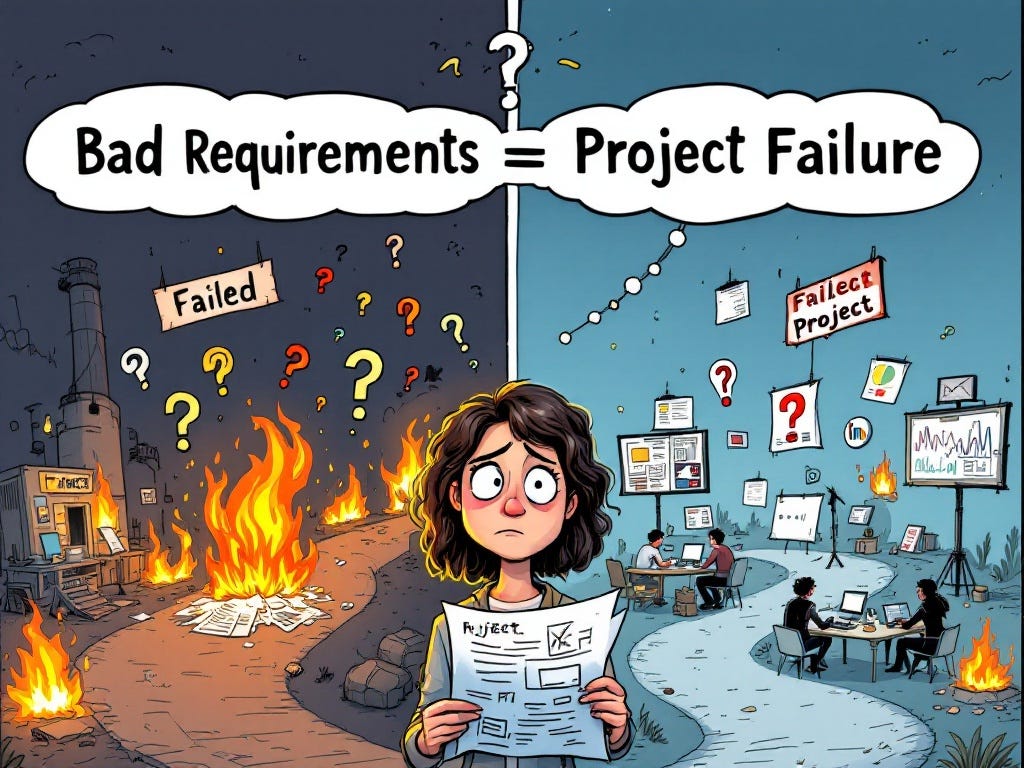Why Solid Requirements Are the Bedrock of Software Success?
Unlock the Secrets to Avoiding Costly Rework and Building Unshakeable Project Foundations
Why Most Software Projects Fail—And How Solid Requirements Can Save Yours
The Common Pitfall Everyone Overlooks
You’ve seen it before: a software project starts with excitement, only to derail into endless delays, budget overruns, and frustration. But here’s the surprising truth—most of these failures don’t come from bad code or weak teams.
They happen because of bad requirements.
The Hidden Cost of Weak Requirements
What if I told you that 70-85% of rework costs in software projects stem from poorly defined requirements? It’s not a bug problem—it’s a blueprint problem. And yet, requirement engineering is often rushed, treated as an afterthought, or—worse—left entirely to developers to figure out.
But here’s what everyone misses: the real success of a project is determined before a single line of code is written.
Why Requirement Engineering Is Your Secret Weapon
Think of building software like constructing a skyscraper. You wouldn’t start without a solid blueprint, right? Without precise requirements, you’re working blind, leading to:
❌ Scope Creep – Constant changes disrupt progress.
❌ Missed Expectations – The final product doesn’t match the vision.
❌ Budget Blowouts – Rework eats into resources.
❌ Project Failures – According to the Standish Group’s Chaos Report, only 29% of projects are successful, and poor requirements are a top reason.
Yet, despite these risks, teams often jump straight into coding with vague, incomplete requirements—setting themselves up for failure before they even begin.
The Counterintuitive Insight: Why “Flexible” Requirements Lead to Rigid Problems
Many teams assume that keeping requirements flexible will lead to a more adaptive, agile process. The truth? It usually causes chaos.
A lack of defined requirements doesn’t lead to agility—it leads to confusion, wasted effort, and frustrated stakeholders. Agile doesn’t mean no requirements; it means smart, iterative requirements that evolve with structure.
The key? Well-defined, yet adaptable requirements—structured enough to guide development, flexible enough to refine as insights emerge.
6 Proven Strategies to Nail Requirement Engineering
1. Start with the Right Stakeholders—Not Just the Loudest Ones
The biggest mistake? Only gathering input from executives or product owners. The real insights come from end-users, customer support teams, and even competitors' customers.
✅ Action Tip: Run stakeholder interviews across different roles to capture diverse needs and pain points.
2. Use the MoSCoW Method to Prioritize What Truly Matters
Not all requirements are created equal. The MoSCoW method breaks them down into:
✅ Must-haves – Essential features that define project success.
✅ Should-haves – Important but not critical.
✅ Could-haves – Nice-to-have features that won’t break the project if excluded.
✅ Won’t-haves – Features that are explicitly deprioritized.
Surprising Fact: The most successful projects actively remove non-essential features early on to maintain focus.
3. Validate Early and Often—Avoid the “Big Reveal” Failure
Many teams gather requirements at the start and never revisit them—only to discover misalignment after months of work.
✅ Action Tip: Set up rapid feedback loops—wireframes, user testing, and weekly stakeholder reviews—to course-correct before problems snowball.
4. Use Visual Models to Avoid Ambiguity
Misunderstandings aren’t just a language issue—they’re a visualization issue.
✅ Solution: Replace long text-based requirement documents with:
📌 User flow diagrams
📌 Wireframes
📌 Storyboarding
This reduces misinterpretation and speeds up development.
5. Plan for Change—But Control It
Agility isn’t about letting scope run wild. It’s about structured adaptability.
✅ Action Tip: Implement a formal change control process—every requirement change should be assessed for its impact on timeline, budget, and dependencies.
6. Stop Relying on Email for Requirement Clarifications
One of the biggest silent killers of project momentum? Long email threads full of unclear back-and-forth conversations.
✅ Solution: Use real-time collaboration tools (Confluence, Jira, Miro) and short video calls for requirement discussions.
A 5-minute call can save dozens of misinterpreted emails.
Tips from My Experience:
Tracking Changes & Sharing Knowledge:
One of my favorite tools is a simple change-tracking tool that helps me track and manage requirements. I also document my learnings so that my fellow BAs have a go-to resource for future reference.Real-Time Collaboration Over Email Chains:
I can’t stress enough how much quicker and more effective real-time communication is. I encourage my developers and testers to jump on calls for clarification instead of relying solely on email chains. Afterward, I follow up with a concise summary to keep things clear.
The Takeaway: The Best Developers Can’t Save a Bad Plan
Here’s the truth: Requirement engineering isn’t just about documentation—it’s about ensuring alignment, preventing failure, and creating a shared vision.
Even the best developers can’t salvage a project doomed by unclear requirements. But with the right strategies, you can build software that’s:
✅ On time
✅ Within budget
✅ Exactly what stakeholders need
Now, I’d love to hear from you:
What’s the biggest requirement-related challenge you’ve faced in a project? Let’s discuss below! ⬇️
Ready to revolutionize your BA practices? Subscribe for detailed guides and join our community of forward-thinking BAs, Product Owners, Developers, and Testers. Together, we can unlock the true potential of Business Analysis and drive impactful change across industries.




